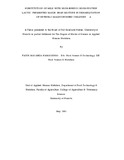| dc.description.abstract | High-energy milk (HEM) consisting of cow's milk, oil and sugar is used in the
rehabilitation diet of children at the Mwanamugimu Nutrition Unit. In this
. study a mixture of lactic fermented maize and beans was, used as a substitute
for the HEM, in a bid to reduce rehabilitation costs. The maize-bean flour
containing 14.6 % protein was used to prepare a high-energy high-protein
porridge (HEP), containing 15% total solids. This was liquefied using of
Millet Amylase Rich Flour (ARF). The energy and protein density for the
HEP was found to be 0.9 kcaljml and 0.027g Iml respectively. This compares
well with 1.0 kcaljml and 0.0355 g protein Iml for HEM. It is however higher
than the protein and caloric content of Ordinary porridge, (OP), which is
commonly used by mothers as a complementary food in Uganda.
The performance of HEP, as substitute for HEM in feeding severely
malnourished children at the unit, was then investigated. HEM was
substituted bv HEP in the diet of some of the children in the rehabilitation
phase at the unit. This was referred to as the HEP group of children. The
comparison group (HEM group) remained on HEM. For both groups other
foods that are normally given to children at the unit were fed.
The HEP group consisted of 39 children while the HEM group had 43
children. The food intake, children's weights as well as the occurrence of
diarrhoea and other illnesses were monitored during the study period. The
socio-economic and demographic characteristics of the study children and
those of their parents and families were obtained using a questionnaire
interview.
No significant difference was observed in the sensory acceptability between
HEP and OP, by mothers. 70% of the children who were given HEP accepted
it.
XlI
The caloric intakes (per kg body weight/ day) were 168±38.1 and 153.7±36.9
for the HEP and HEM groups respectively. The protein intakes (g/kg
Bwt/ day) were 6 ± 2 and 5.6 ± 2.5 for the HEP and HEM groups respectively.
The caloric and protein intakes showed no statistical difference (P>0.05). Both
groups took levels of calories and protein adequate for the treatment of
protein energy malnutrition.
Growth rates in the first seven days of stay in the study were 10 and 7
grams/kg body weight/ day, for the HEP and HEM groups respectively.
These were statistically different (p<0.05). However, the overall growth
rates, for the entire period of stay in the study (8 and 7 grams/kg body
weight/ day for the HEP and HEM groups respectively), were not statistically
different. Growth that is adequate in the treatment of PEM was achieved in
both study groups. It can be concluded that HEP is a better media for catchup
growth during the first seven days of rehabilitation phase, when the
body's deficit for energy and other nutrients is high. After the deficit is
cleared growth continues at more or less the same rate on both HEM and
HEP. Study results indicated no difference in the experience of diarrhoea and
other illnesses between the-study groups.
Both groups of study children came from families of low socio-economic
status.
It was also concluded that a protein and energy dense porridge (HEP), could
be produced from a lactic fermented kidney beans-maize mixture by
incorporation of millet ARF. It is a suitable substitute for milk in the
rehabilitation diet for severely malnourished children. In addition, its caloric
and protein content make it a suitable complementary food, for healthy
children. It is inexpensive and has a potential for acceptability by mothers,
and children, making it ideal for use in the rural and peri-urban areas of
Uganda and other countries where prevalence of malnutrition is high. | en |

